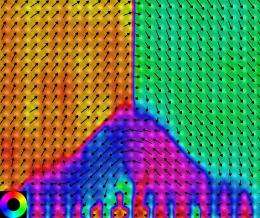Fundamental discovery could lead to better memory chips

(PhysOrg.com) -- Engineering researchers at the University of Michigan have found a way to improve the performance of ferroelectric materials, which have the potential to make memory devices with more storage capacity than magnetic hard drives and faster write speed and longer lifetimes than flash memory.
In ferroelectric memory the direction of molecules' electrical polarization serves as a 0 or a 1 bit. An electric field is used to flip the polarization, which is how data is stored.
With his colleagues at U-M and collaborators from Cornell University, Penn State University, and University of Wisconsin, Madison, Xiaoqing Pan, a professor in the U-M Department of Materials Science and Engineering, has designed a material system that spontaneously forms small nano-size spirals of the electric polarization at controllable intervals, which could provide natural budding sites for the polarization switching and thus reduce the power needed to flip each bit.
"To change the state of a ferroelectric memory, you have to supply enough electric field to induce a small region to switch the polarization. With our material, such a nucleation process is not necessary," Pan said. "The nucleation sites are intrinsically there at the material interfaces."
To make this happen, the engineers layered a ferroelectric material on an insulator whose crystal lattices were closely matched. The polarization causes large electric fields at the ferroelectric surface that are responsible for the spontaneous formation of the budding sites, known as "vortex nanodomains."
The researchers also mapped the material's polarization with atomic resolution, which was a key challenge, given the small scale. They used images from a sub-angstrom resolution transmission electron microscope at Lawrence Berkeley National Laboratory. They also developed image processing software to accomplish this.
"This type of mapping has never been done," Pan said. "Using this technique, we've discovered unusual vortex nanodomains in which the electric polarization gradually rotates around the vortices."
More information: A paper on the research, titled "Spontaneous Vortex Nanodomain Arrays at Ferroelectric Heterointerfaces" is available online at Nano Letters website.
Provided by University of Michigan

















